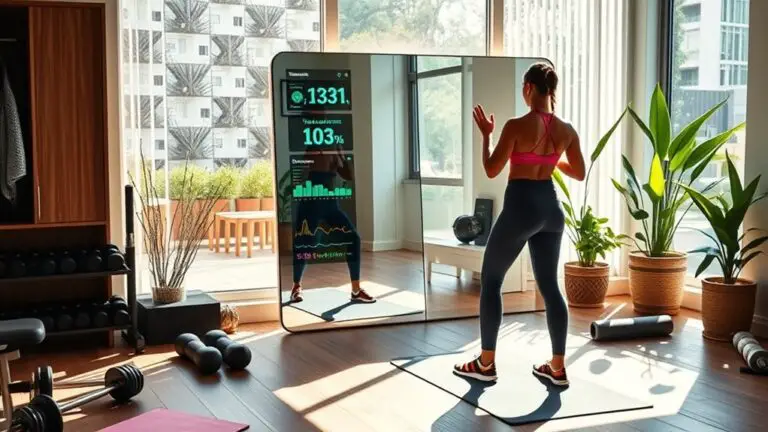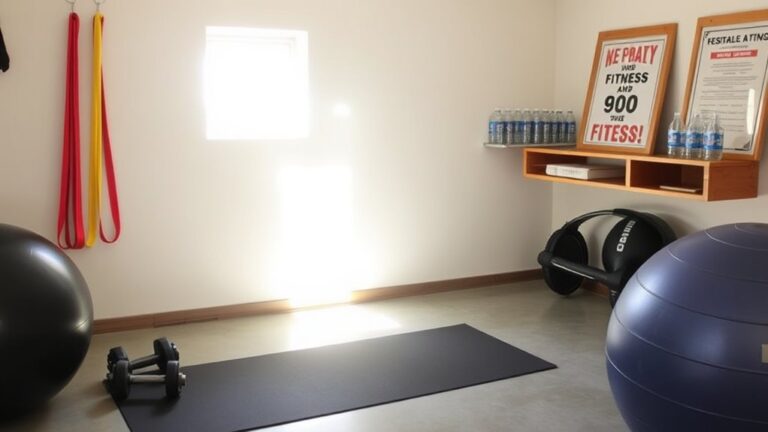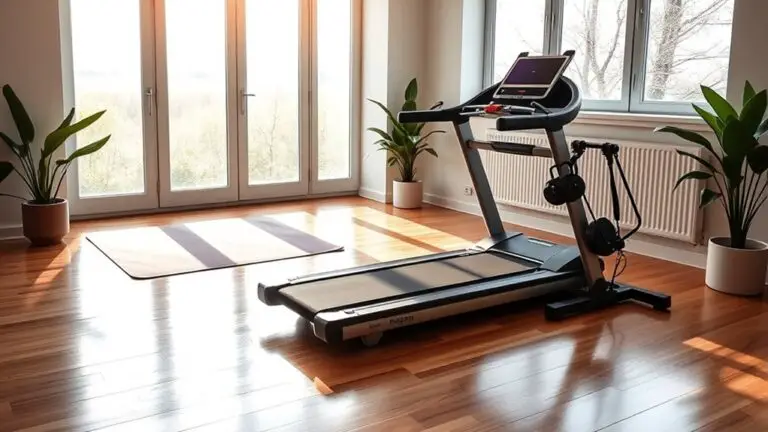How to Soundproof Your Home Gym for Heavy Lifting
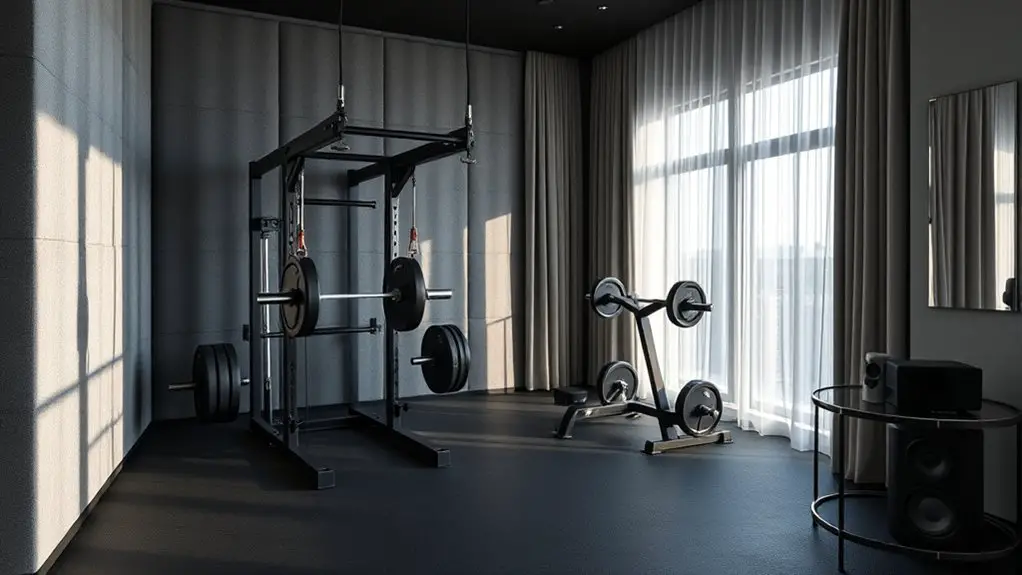
To soundproof your home gym for heavy lifting, start by identifying noise sources like equipment and vibrations. Use dense materials like acoustic panels and soundproof curtains to minimize sound transmission. Implement sound barriers, such as mass-loaded vinyl, and guarantee heavy equipment is positioned away from shared walls. Invest in rubber flooring for impact absorption and consider adding wall insulation for greater soundproofing. By addressing these aspects, you can create a quieter workout environment and discover more effective strategies along the way.
Assessing Your Space and Identifying Noise Sources
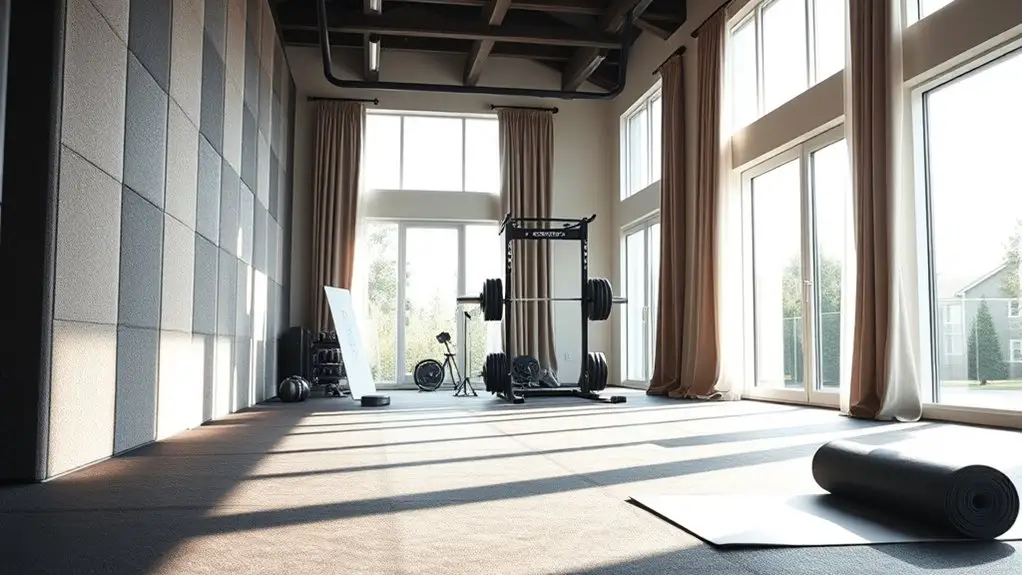
Before you can effectively soundproof your home gym, you need to assess your space and identify the primary sources of noise. Start by examining both external and internal factors contributing to noise pollution. External sources can include traffic, neighbors, or nearby construction. Internally, focus on equipment like treadmills, weights, and even your own movements.
Next, evaluate your walls, floors, and ceilings for their current sound insulation capabilities. If your gym is in a basement, concrete may help reduce noise but not eliminate it. Consider how sound travels; hard surfaces reflect noise, while softer materials absorb it.
Make a list of these noise sources and their potential impact on your workouts. This assessment will guide you in selecting appropriate soundproofing strategies and materials, ensuring a quieter and more focused exercise environment. Taking these initial steps is essential for effective sound insulation.
Choosing the Right Soundproofing Materials
When it comes to soundproofing your home gym, selecting the right materials is essential for achieving ideal results. Acoustic panels are a top choice, as they absorb sound waves, reducing echo and minimizing noise transmission. These panels can be strategically placed on walls or ceilings to target specific sound frequencies generated during heavy lifting.
Additionally, soundproof curtains are effective for covering windows and doors, preventing outside noise from intruding and keeping gym sounds from escaping. Look for thick, heavy fabrics that provide better sound insulation.
When choosing materials, consider their density and thickness; denser materials tend to offer superior soundproofing. Combining these materials can enhance your gym’s acoustics markedly, creating an environment conducive to focused workouts. Remember, investing in quality soundproofing materials will pay off in both performance and comfort.
Implementing Effective Soundproofing Techniques

After selecting the right soundproofing materials, implementing effective techniques is key to maximizing their impact. Start by strategically placing acoustic panels on your walls to absorb sound waves, reducing echo and reverberation. Focus on areas where sound reflects the most, like corners and flat surfaces. Next, install sound barriers, such as mass-loaded vinyl or soundproof drywall, to block noise from escaping your gym. Confirm these barriers are properly sealed at edges and seams for ideal performance.
Consider using heavy curtains or blinds on windows to further minimize sound leakage. If possible, create a soundproof door by adding weather stripping or a door sweep to eliminate gaps. Finally, remember to assess your gym’s layout; positioning heavy equipment away from shared walls can greatly diminish noise transmission. By applying these techniques, you’ll create a quieter environment for both your workouts and your neighbors.
Enhancing Floor and Wall Treatments
Although you may have already implemented various soundproofing techniques, enhancing your floor and wall treatments can greatly improve your home gym’s acoustic performance. Start by installing rubber flooring; it’s dense and absorbs impact sound effectively, reducing noise caused by heavy lifting. Rubber flooring also provides a non-slip surface, enhancing safety during your workouts. Additionally, choosing the right thickness of rubber flooring can further optimize sound absorption and protect your flooring from damage. Next, consider adding acoustic panels to your walls. These panels are designed to absorb sound waves, minimizing echo and reverberation within the space. Position them strategically around your gym, particularly in areas where sound reflection is most pronounced.
If you’re looking for a more extensive solution, you can combine these treatments with wall insulation or soundproofing drywall. This multi-layered approach will remarkably decrease the transmission of sound, ensuring that both your workouts and the peace of your household are preserved. By enhancing your floor and wall treatments, you’re taking an essential step toward a quieter workout environment.
Additional Tips for Maintaining a Quiet Workout Environment
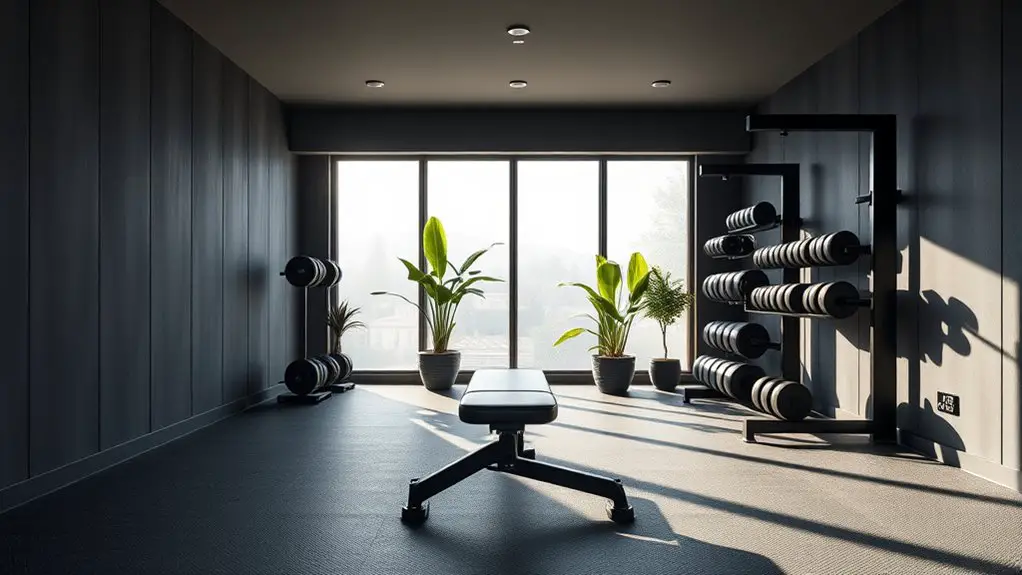
To maintain a quiet workout environment, it is essential to be mindful of your equipment and routine. Start by investing in noise reducing equipment, such as rubber mats or specialized weights designed to minimize sound during use. These options can greatly dampen vibrations and impact noise.
Additionally, consider your workout scheduling. Plan your sessions during times when noise is less likely to disturb others. Early mornings or late evenings may be ideal, depending on your household dynamics. If you’re lifting heavy, opt for lighter weights or bodyweight exercises during noise-sensitive hours.
Finally, keep your space organized. Clutter can lead to accidents, causing additional noise. By streamlining your workout area and ensuring everything has a designated place, you can enhance your focus while reducing potential disturbances. Prioritizing these strategies will help you enjoy a quieter, more effective workout experience.
Frequently Asked Questions
Can I Soundproof a Gym in an Apartment?
Yes, you can soundproof a gym in an apartment effectively. Start by investing in apartment soundproofing materials like acoustic panels or foam, which absorb sound. Adding heavy curtains or rugs can help with gym noise reduction as well. Consider isolating your equipment with rubber mats to minimize vibrations. Seal any gaps in walls or doors to prevent sound leakage. With these strategies, you’ll create a quieter workout space without disturbing your neighbors.
How Much Does Soundproofing Typically Cost?
On average, soundproofing a space can range from $1,000 to $3,000, depending on the materials you choose. A study found that effective soundproofing can reduce noise by up to 30 decibels. If you’re considering a cost comparison, high-density foam panels are more affordable but less effective than mass-loaded vinyl. Ultimately, investing in quality soundproofing materials can greatly enhance your environment, so weigh your options carefully based on your specific needs.
Will Soundproofing Affect My Workout Ventilation?
Soundproofing can indeed affect your workout ventilation. If you’re installing soundproofing materials, consider how they’ll interact with your ventilation systems. Some materials may limit air circulation, causing potential issues with air quality and temperature. It’s vital to guarantee that your ventilation systems remain effective while soundproofing. You might need to invest in specialized ductwork or fans to maintain proper airflow, confirming your gym remains comfortable and functional during intense workouts.
Can I Use Acoustic Panels Outdoors?
You can’t typically use standard acoustic panels outdoors, as they aren’t designed for weather resistance. For outdoor acoustics, you’ll need specialized panels that can withstand moisture and temperature fluctuations without degrading. These panels are made from durable materials that resist mold and mildew, making them suitable for exterior use. If you’re looking to manage noise outside, make sure to choose products explicitly labeled for outdoor applications to guarantee effectiveness and longevity.
Do Soundproofing Materials Need Maintenance?
Yes, soundproofing materials do have maintenance requirements, although they generally have a long soundproofing lifespan. Depending on the type of material used, you might need to periodically check for damage or wear. For instance, acoustic panels can accumulate dust and may require cleaning to maintain their effectiveness. Additionally, if you use foam or insulation, verify they haven’t degraded over time. Regular inspections will help you keep your soundproofing in peak condition.

